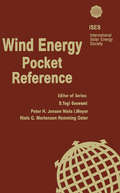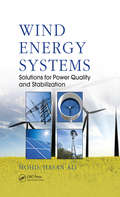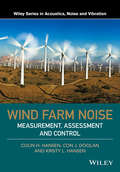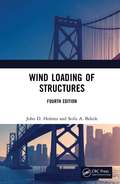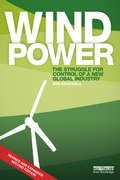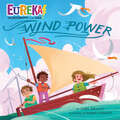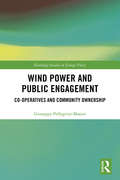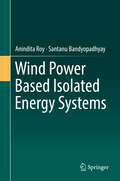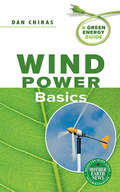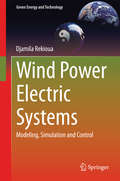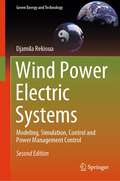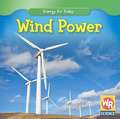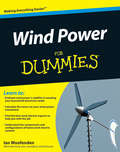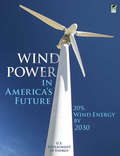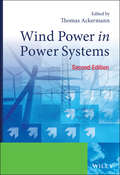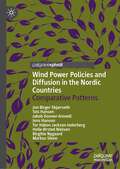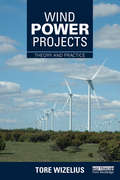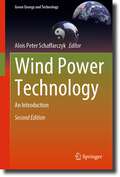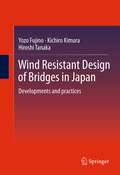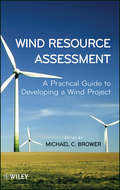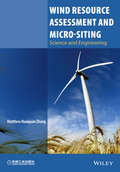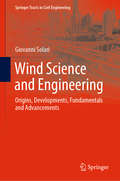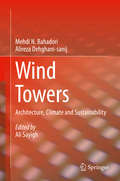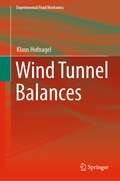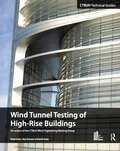- Table View
- List View
Wind Energy Pocket Reference (Energy Pocket Reference)
by Niels I. Meyer Peter Hjuler Jensen Niels Gylling Mortensen Flemming OsterPrepared and peer-reviewed by some of the foremost experts in the field, this easy-to-use pocket reference offers a wealth of information relating to wind energy and wind energy technologies. Topics covered range from wind resources to wind turbines, covering offshore and onshore power, both stand-alone and grid-connected. The book also includes vital information on international economic support schemes and incentives and environmental issues and is peppered throughout with helpful illustrations, equations and explanations. Renewable energy professionals, students and wind energy entrepreneurs amongst others will find a host of answers in this essential book – a practical assimilation of data, fundamentals and guidelines for application.
Wind Energy Systems: Solutions for Power Quality and Stabilization
by Mohd. AliUnlike conventional power plants, wind plants emit no air pollutants or greenhouse gases—and wind energy is a free, renewable resource. However, the induction machines commonly used as wind generators have stability problems similar to the transient stability of synchronous machines. To minimize power, frequency, and voltage fluctuations caused by network faults or random wind speed variations, control mechanisms are necessary. Wind Energy Systems: Solutions for Power Quality and Stabilization clearly explains how to solve stability and power quality issues of wind generator systems. Covering fundamental concepts of wind energy conversion systems, the book discusses several means to enhance the transient stability of wind generator systems. It also explains the methodologies for minimizing fluctuations of power, frequency, and voltage. Topics covered include: An overview of wind energy and wind energy conversion systems, Fundamentals of electric machines and power electronics, Types of wind generator systems, Challenges in integrating wind power into electricity grids, Solutions for power quality problems, Methods for improving transient stability during network faults, Methods for minimizing power fluctuations of variable-speed wind generator systems This accessible book helps researchers and engineers understand the relative effectiveness of each method and select a suitable tool for wind generator stabilization. It also offers students an introduction to wind energy conversion systems, providing insights into important grid integration and stability issues.
Wind Farm Noise: Measurement, Assessment, and Control
by Colin H. Hansen Con J. Doolan Kristy L. HansenWind Farm Noise: Measurement, Assessment and Control Colin H Hansen, University of Adelaide, Australia Con J Doolan, University of New South Wales, Australia Kristy L Hansen, Flinders University, Australia A comprehensive guide to wind farm noise prediction, measurement, assessment, control and effects on people Wind Farm Noise covers all aspects associated with the generation, measurement, propagation, regulation and adverse health effects of noise produced by large horizontal-axis wind turbines of the type used in wind farms. The book begins with a brief history of wind turbine development and the regulation of their noise at sensitive receivers. Also included is an introductory chapter on the fundamentals of acoustics relevant to wind turbine noise so that readers are well prepared for understanding later chapters on noise measurements, noise generation mechanisms, noise propagation modelling and the assessment of the noise at surrounding residences. Key features: • Potential adverse health effects of wind farm noise are discussed in an objective way. • Means for calculating the noise at residences due to a wind farm prior to construction are covered in detail along with uncertainty estimates. • The effects of meteorological conditions and other influences, such as obstacles, ground cover and atmospheric absorption, on noise levels at residences are explained. • Quantities that should be measured as well as how to best measure them in order to properly characterise wind farm noise are discussed in detail. • Noise generation mechanisms and possible means for their control are discussed as well as aspects of wind farm noise that still require further research to be properly understood. The book provides comprehensive coverage of the topic, containing both introductory and advanced level material.
Wind Loading of Structures
by John D. Holmes Seifu BekeleWind forces from extreme wind events are the dominant loading for many parts of the world, exacerbated by climate change and the continued construction of tall buildings and structures. This authoritative source, for practising and academic structural engineers and graduate students, ties the principles of wind loads on structures to the relevant aspects of meteorology, bluff-body aerodynamics, probability and statistics, and structural dynamics. This new edition covers: Climate change effects on extreme winds – particularly those from tropical cyclones, hurricanes and typhoons Modelling of potential wind vulnerability and damage Developments in extreme value probability analysis of extreme wind speeds and directions Explanation of the difference between ‘return period’ and ‘average recurrence interval’, as well as ‘bootstrapping’ techniques for deriving confidence limits Wind over water, and profiles and turbulence in non-synoptic winds An expanded chapter on internal pressures produced by wind for various opening and permeability scenarios Aerodynamic shaping of high- and low-rise buildings Recent developments in five major wind codes and standards A new chapter on computational fluid dynamics (CFD), as applied to wind engineering A greatly expanded appendix providing the basic information on extreme wind climates for over 140 countries and territories Additional examples for many chapters in this book
Wind Power: The Struggle for Control of a New Global Industry
by Ben BackwellThe wind power business has grown from a niche sector within the energy industry to a global industry that attracts substantial investment. In Europe wind has become the biggest source of new power generation capacity, while also successfully competing with the gas, coal and nuclear sectors in China and the US. Wind Power looks at the nations, companies and people fighting for control of one of the world’s fastest growing new industries and how we can harness one of the planet’s most powerful energy resources. The book examines the challenges the sector faces as it competes for influence and investment with the fossil fuel industry across the globe. Over the course of this volume, Backwell analyses the industry climbers, the investment trends and the technological advancements that will define the future of wind energy. This second edition is revised throughout and contains new material on frontier wind markets and industry consolidation, as well as the cost reductions and market gains that led to 2015 being a landmark year for the big wind turbine companies. This is an important resource for professionals working in wind and wider renewable industries, energy finance, conventional energy companies and government as well as researchers, students, journalists and the general public.
Wind Power (Eureka! The Biography of an Idea)
by Laura DriscollBlow, wind, blow! The newest addition to the nonfiction Eureka! series is a &“biography&” of wind power, which is green energy that can help the planet.People have harnessed the power of the wind for thousands of years, to travel by sailboat, to cool homes, to grind grain into flour, and even to make music. But when someone hooked a wind mill to a generator, wind went electric, unlocking the secret to a clean, renewable energy source! Wind Power is an entertaining and informative look at the development of an idea with huge benefits for a greener future. This STEAM nonfiction title is part of the Eureka! series, with each book focusing on one groundbreaking, world-changing discovery that millions of people use every single day.
Wind Power and Public Engagement: Co-operatives and Community Ownership (Routledge Studies in Energy Policy)
by Giuseppe Pellegrini-MasiniAdopting an interdisciplinary social science approach, this book examines community reactions to wind farms to form a new understanding of what facilitates social acceptance. Based on empirical research, Wind Power and Public Engagement investigates opposition to wind energy and considers the advantages as well as the limits of the co-operative model of wind farm community ownership. Giuseppe Pellegrini-Masini compares the role of co-operative schemes with community benefits schemes in increasing acceptability, and also sheds light on the impact of social factors including pro-environmental attitudes, perceived benefits and costs, place attachment, trust, as well as individuals’ resources such as information and income. Five research cases are investigated in England and Scotland, including the first local, community-owned wind farm co-operative in the UK. Critically reviewing existing social research theories, the book offers a new viewpoint, integrating rational choice and environmental attitudinal theories, from which to assess and understand the social acceptability of wind energy. It also highlights new opportunities for raising consensus in communities around locally proposed wind farms. The book will be of great interest to students and scholars of renewable energy, energy policy, environmental sociology, environmental psychology, environmental planning and sustainability in general, as well as policymakers.
Wind Power Based Isolated Energy Systems
by Anindita Roy Santanu BandyopadhyayThis book offers methods to improve energy access and support social and economic development through the appropriate and reliable design of isolated wind energy systems. The findings reported on wind based isolated power generation show that the proper match of turbine diameter and generator rating is vital, and is governed by the site wind resource and the load profile to be served. The methodology for sizing and selecting appropriate system parameters, taking into account the resource uncertainty, is demonstrated throughout the chapters of this monograph. Readers will discover information on the methodologies for modelling, design and optimization of the systems in terms of safety, functionality, longevity, and practicality. Details are provided on the design space of wind-battery systems, multiple wind generator systems, and wind-PV-battery hybrids to cover all the bases of isolated wind energy systems. This monograph aims to serve as a guide to system developers, manufacturers, and financing institutions on the design aspects of isolated wind energy systems.
Wind Power Basics
by Dan ChirasWind energy is the fastest growing source of energy in the world, and by the year 2020 it is projected to supply at least 12 percent of global electrical demand.Wind Power Basics provides a clear understanding of wind and wind energy systems, including turbines, towers, inverters and batteries, site assessment, installation, and maintenance requirements.Whether you're considering your own small-scale wind energy system or just want a straightforward, detailed introduction to the benefits and challenges of this rapidly emerging technology, Wind Power Basics is the guide you need.Dan Chiras is a respected educator and an internationally acclaimed author who has published more than twenty-five books on residential renewable energy and green building, including Power From the Wind.
Wind Power Electric Systems
by Djamila RekiouaThe book helps readers understand key concepts in standalone and grid connected wind energy systems and features analysis into the modeling and optimization of commonly used configurations through the implementation of different control strategies. Utilizing several electrical machinery control approaches, such as vector control and direct torque control 'Wind Power Electric Systems' equips readers with the means to understand, assess and develop their own wind energy systems and to evaluate the performance of such systems. Mathematical models are provided for each system and a corresponding MATLAB/SIMULINK example is included at the end of each section in order to demonstrate key processes and methods.
Wind Power Electric Systems: Modeling, Simulation, Control and Power Management Control (Green Energy and Technology)
by Djamila RekiouaThis book enhances existing knowledge in the field of wind systems. It explores topics such as grid integration, smart grid applications, hybrid renewable energy systems, and advancements in control and optimization approaches. The book primarily aims to provide a quick and comprehensive understanding of wind systems, including models, control techniques, optimization methods, and energy storage systems to students at both undergraduate and postgraduate levels, particularly those studying electrical engineering.The book is divided into two parts. The first part explores various stand-alone wind applications such as rural electrification and pumping, while the second part focuses on applications in grid-connected systems. Each system is accompanied by mathematical models and an illustrative example using the MATLAB/Simulink package. Moreover, numerous examples are presented for potential implementation using the DSPACE package. The book also introduces different electrical machine control approaches, including vector control, direct torque control, and fuzzy logic controllers for various drive systems. Furthermore, intelligent techniques are developed to optimize wind operations.Aiming to enhance existing knowledge in the field of wind systems, this book covers topics such as grid integration, smart grid applications, hybrid renewable energy systems, and advancements in control and optimization approaches.This second edition is fully updated. New sections on demand-side management and energy storage systems have been included, and each section has a summary and comparative table to further enhance clarity. Additionally, this new edition includes discussions on future trends and emerging technologies in wind energy systems, making it a more comprehensive and up-to-date resource.
Wind Power (Energy for Today)
by Tea BenduhnWind Power: A waving flag, blowing leaves, a kite soaring through the sky-all are moved by wind power. Wind is also our fast-growing source of energy. Find out how wind forms and the different ways we may use it in the future.
Wind Power For Dummies
by Ian WoofendenThe consumer guide to small-scale wind electricity production!Maybe you're not T. Boone Pickens, but you can build your own home-sized wind-power empire right in your back yard. Wind Power For Dummies supplies all the guidance you need to install and maintain a sustainable, cost-effective wind generator to power your home for decades to come.This authoritative, plain-English guide walks you through every step of the process, from assessing your site and available wind sources to deciding whether wind power is the solution for you, from understanding the mechanics of wind power and locating a contractor to install your system to producing your own affordable and sustainable electricity.Guides you step by step through process of selecting, installing, and operating a small-scale wind generator to power your homeDemystifies system configurations, terminology, and wind energy principles to help you speak the language of the prosHelps assess and reduce your energy needs and decide whether wind power is right for youExplains the mechanics of home-based wind powerShows you how to tie into the grid and sell energy back to the power companyOffers advice on evaluating all of the costs of and financing for your projectProvides tips on working with contractors and complying with local zoning lawsYes, you can do it, with a little help from Wind Power For Dummies.
Wind Power in America's Future: 20% Wind Energy by 2030
by U.S. Department of EnergyWind power represents a critical component of the strategies to reduce air and water pollution and to combat the effects of global climate change. Further, the development of wind farms promises to provide jobs and income to farmers and rural economies throughout the nation. This survey covers the history of the U.S. wind industry: how it works, its geography, and its impact on the environment.A collaborative panel—including members of the U.S. Department of Energy—explored a modeled energy scenario in which wind would provide 20 percent of the nation's electricity by 2030. This official 2008 report by the panel estimates impacts and discusses specific needs and outcomes in the areas of technology, manufacturing, transmission and grid integration, markets, siting strategies, and potential environmental effects.
Wind Power in Power Systems
by Thomas AckermannThe second edition of the highly acclaimed Wind Power in Power Systems has been thoroughly revised and expanded to reflect the latest challenges associated with increasing wind power penetration levels. Since its first release, practical experiences with high wind power penetration levels have significantly increased. This book presents an overview of the lessons learned in integrating wind power into power systems and provides an outlook of the relevant issues and solutions to allow even higher wind power penetration levels. This includes the development of standard wind turbine simulation models. This extensive update has 23 brand new chapters in cutting-edge areas including offshore wind farms and storage options, performance validation and certification for grid codes, and the provision of reactive power and voltage control from wind power plants. Key features:Offers an international perspective on integrating a high penetration of wind power into the power system, from basic network interconnection to industry deregulation;Outlines the methodology and results of European and North American large-scale grid integration studies;Extensive practical experience from wind power and power system experts and transmission systems operators in Germany, Denmark, Spain, UK, Ireland, USA, China and New Zealand;Presents various wind turbine designs from the electrical perspective and models for their simulation, and discusses industry standards and world-wide grid codes, along with power quality issues;Considers concepts to increase penetration of wind power in power systems, from wind turbine, power plant and power system redesign to smart grid and storage solutions.Carefully edited for a highly coherent structure, this work remains an essential reference for power system engineers, transmission and distribution network operator and planner, wind turbine designers, wind project developers and wind energy consultants dealing with the integration of wind power into the distribution or transmission network. Up-to-date and comprehensive, it is also useful for graduate students, researchers, regulation authorities, and policy makers who work in the area of wind power and need to understand the relevant power system integration issues.
Wind Power Policies and Diffusion in the Nordic Countries: Comparative Patterns
by Jon Birger Skjærseth Teis Hansen Jakob Donner-Amnell Jens Hanson Helle Ørsted Nielsen Birgitte Nygaard Markus Steen Tor Håkon InderbergThis book focuses specifically on policy mixes and wind power diffusion in four Nordic countries – Denmark, Finland, Norway and Sweden. Although these Nordic welfare states have much in common, they have adopted different wind power policies and experienced dissimilar diffusion trajectories. Understanding these patterns across the Nordic countries is the central puzzle that this book investigates. Empirically, this book provides a first-of-its-kind comparative study of wind power policies in the Nordic countries. Analytically, the authors contribute to the transition policy mix literature, which remains largely insensitive to political feasibility. This book will be of interest to researchers and students as well as private and public decision makers looking for tools to enable the energy transition.
Wind Power Projects: Theory and Practice
by Tore WizeliusWind power has developed rapidly in terms of the number of new wind power plants now installed in more than hundred countries around the world. This renewable energy source has become competitive, and to be able to combat climate change much more has to be installed in coming years. This also makes it necessary for policy makers, NGOs, research scientists, industry and the general public to have a basic understanding of wind power. The majority of texts on wind power are written primarily for engineers or policy analysts. This book specifically targets those interested in, or planning to develop wind power projects. It can be understood by both specialists and non-specialists interested in wind power project development. Having outlined the background of wind power and its development, explained wind resources and technology, the author explores the interactions between wind power and society and the role of wind power in the electric power system. Finally the main aspects of project development, including siting, economics and legislation, are explained. This book will be an essential reference, or even a manual, for professionals developing new sites and for government officials and consultants involved in the planning or permission process. It can also be used as a textbook on wind power at schools and universities.
Wind Power Technology: An Introduction (Green Energy and Technology)
by Alois Peter SchaffarczykThis textbook provides in-depth treatment of all systems associated with wind energy, including the aerodynamic and structural aspects of blade design, the flow of energy and loads through the wind turbine, the electrical components and power electronics including control systems. It explains the importance of wind resource assessment techniques, site evaluation and ecology and describes the integration of wind farms into the electrical grid. The reader will also become familiar with the offshore technology, the youngest and most promising aspect of wind energy. The completely revised and updated new edition provides new sections on fatigue design, analytical models for structural analysis and topology optimization. The book is written by experts in research, teaching and industry. It conveys the importance of wind energy in the international energy policy debate and offers clear insight into the subject for all students learning about wind engineering. Problems with solutions are perfect for self-study. It is also an authoritative resource for engineers designing and developing wind energy systems, energy policy-makers and economists in the renewable energy sector.The translation of some chapters was done with the help of artificial intelligence (machine translation by the service DeepL.com). A subsequent human revision was done primarily in terms of content.
Wind Resistant Design of Bridges in Japan
by Hiroshi Tanaka Kichiro Kimura Yozo FujinoFor long-span bridges, wind action is a dominant factor in their safety and serviceability. A large number of long-span bridges have been built in Japan over the past 30 years, and tremendous amounts of research and technical development have been accomplished in wind-resistant design. This book is a compilation of the results of active research and development. Wind-resistant design standards generated in Japan are described in the first few chapters. Then comes information such as design wind speed, structural damping, wind tunnel tests, and analyses, which provide the basis of the design standards. Wind-induced vibrations and their control of girders, towers, cables, and other features are explained with examples of field measurements. Comprehensive listings of Japanese experience in vibration control are also presented. Because achieving particularly dynamic safety against wind is still not an easy task, these data and information will be valuable assets for the wind-engineering and bridge-engineering communities.
Wind Resource Assessment
by Michael BrowerA practical, authoritative guide to the assessment of wind resources for utility-scale wind projects-authored by a team of experts from a leading renewable energy consultancyThe successful development of wind energy projects depends on an accurate assessment of where, how often, and how strongly the wind blows. A mistake in this stage of evaluation can cause severe financial losses and missed opportunities for developers, lenders, and investors.Wind Resource Assessment: A Practical Guide to Developing a Wind Project shows readers how to achieve a high standard of resource assessment, reduce the uncertainty associated with long-term energy performance, and maximize the value of their project assets. Beginning with the siting, installation, and operation of a high-quality wind monitoring program, this book continues with methods of data quality control and validation, extrapolating measurements from anemometer height to turbine height, adjusting short-term observations for historical climate conditions, and wind flow modeling to account for terrain and surface conditions.In addition, Wind Resource Assessment addresses special topics such as: Worker safety Data security Remote sensing technology (sodar and lidar) Offshore resource assessment Impacts of climate change Uncertainty estimation Plant design and energy production estimatioFilled with important information ranging from basic fundamentals of wind to cutting-edge research topics, and accompanied by helpful references and discussion questions, this comprehensive text-designed for an international audience-is a vital reference that promotes consistent standards for wind assessment across the industry.
Wind Resource Assessment and Micro-siting: Science and Engineering
by Matthew Huaiquan ZhangCovers all the key areas of wind resource assessment technologies from an engineer’s perspective Focuses on wind analysis for wind plant siting, design and analysis Addresses all aspects from atmospheric boundary layer characteristics, to wind resource measurement systems, uncertainties in measurements, computations and analyses, to plant performance Covers the basics of atmospheric science through to turbine siting, turbine responses, and to environmental impacts Contents can be used for research purposes as well as a go-to reference guide, written from the perspective of a hands-on engineer Topic is of ongoing major international interest for its economic and environmental benefits
Wind Science and Engineering: Origins, Developments, Fundamentals and Advancements (Springer Tracts in Civil Engineering)
by Giovanni SolariThis book provides an essential overview of wind science and engineering, taking readers on a journey through the origins, developments, fundamentals, recent advancements and latest trends in this broad field. Along the way, it addresses a diverse range of topics, including: atmospheric physics; meteorology; micrometeorology; climatology; the aerodynamics of buildings, aircraft, sailing boats, road vehicles and trains; wind energy; atmospheric pollution; soil erosion; snow drift, windbreaks and crops; bioclimatic city-planning and architecture; wind actions and effects on structures; and wind hazards, vulnerability and risk. In order to provide a comprehensive overview of wind and its manifold effects, the book combines scientific, descriptive and narrative chapters. The book is chiefly intended for students and lecturers, for those who want to learn about the genesis and evolution of this topic, and for the multitude of scholars whose work involves the wind.
Wind Towers
by Mehdi N. Bahadori Alireza Dehghani-Sanij Ali SayighThis unique volume provides the only holistic treatment of wind towers, a core aspect of sustainable architecture in hot, arid climates. The authors explain how traditional incarnations of these structures provide significant decreases in energy consumption through their use of renewable wind resources to cool buildings and water storage facilities. Beginning with the underlying scientific principles, the design and operation of wind towers is explained in depth and suggestions for optimization are provided, supported by the authors' findings from recent analytical studies.
Wind Tunnel Balances (Experimental Fluid Mechanics)
by Klaus HufnagelThis Handbook helps to design and build any kind of force measurement equipment for the use in a wind tunnel. It is of interest to those who want to build multi-component force measurement sensors for other applications as well. The book describes the basic relations for the design and presents handbook formulas that can be used to perform a primary determination of main dimensions of a specified multi-component force sensor. This Handbook describes material and manufacturing particularities, instrumentation techniques and methods for the compensation of environmental influences. It also discusses calibration problems of multi-component force sensors and methods for the evaluation of the data.
Wind Tunnel Testing of High-Rise Buildings: An Output Of The Ctbuh Wind Engineering Working Group
by David Scott Peter Irwin Roy DenoonSince the 1960s, wind tunnel testing has become a commonly used tool in the design of tall buildings. It was pioneered, in large part, during the design of the World Trade Center Towers in New York. Since those early days of wind engineering, wind tunnel testing techniques have developed in sophistication, but these techniques are not widely understood by the designers using the results. As a direct result, the CTBUH Wind Engineering Working Group was formed to develop a concise guide for the non-specialist. The primary goal of this guide is to provide an overview of the wind tunnel testing process for design professionals. This knowledge allows readers to ask the correct questions of their wind engineering consultants throughout the design process. This is not an in-depth guide to the technical intricacies of wind tunnel testing, it focusses instead on the information the design community needs, including: a unique methodology for the presentation of wind tunnel results to allow straightforward comparison of results from different wind tunnel laboratories. advice on when a tall building is likely to be sufficiently sensitive to wind effects to benefit from a wind tunnel test background for assessing whether design codes and standards are applicable details of the types of tests that are commonly conducted descriptions of the fundamentals of wind climate and the interaction of wind and tall buildings This unique book is an essential guide for all designers of tall buildings, and anyone else interested in the process of wind tunnel testing for tall buildings.
